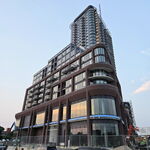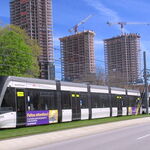The trains are to be supplied as six-car sets of three married pairs as shown in the drawing below. This differs from the TR trains on Lines 1 and 4 which are explicitly configured as 6- and 4-car units respectively.
Configured as such, sure.
But the 4-car TRs are made up of two identical 2-car pairs electronically, and the 6-car ones are made up of two slightly different 3-car couplets.
Just because they can't be taken apart easily doesn't mean that they aren't configured the way they are.
The A cars are cab cars with full controls. The B and C cars are intermediates. All B and C cars will have hostler controls at one end for manual operation as independent sets. This is a different configuration from the TRs which only operate as full trainsets.
-ish.
The B cars have air compressors, the A and C cars do not. This is the same as the TRs. And basically the same as the T1s (and Hs, and M1s, and Gs), where there is an A and B car that each provide different functions to the pair.
The cab-end truck of the A cars will not be powered. This is to avoid ATC position measurement problems caused by wheel slip/spin. A full 6-car train will have 10 powered trucks.
This is the same as the TRs, and most of the modern subways worldwide. And it's not actually to do with ATC systems, although that ends up being a very nice side benefit of it.
Back in the 1960s, a number of different organizations were researching the wheel-rail interface. One of the things noted was that the first pair of wheels (the wheels on the first axle) in a consist had a considerably lower quotient of friction than all of the others trailing. It turns out that this lead set of wheels is cleaning the railhead as it passes, leaving the rest of the wheels with a very clean - and grabby - surface to hold on to when accelerating and braking.
This means a couple of things. One: it is ideal to lower the braking force on that lead set of wheels as it is considerably easier to lock them and have them slide, since they have less friction on the railhead. Two: there was very little difference in the cleaning effect if the axle provided traction power or not. A non-powered axle did just as much work cleaning the railhead as a powered one did. So in this case it was felt that not powering it would save on costs (fewer traction motors, gearboxes, etc.).
The only difference in the specification between a “B” car and a “C” car is that the combination “A-B” (including a cab car) or “B-C” (without a cab car) is possible, but not an “A-C” pair.
It might help if you understand what the difference between the different car types is if you know what they do/what they are for. See above.
From Steven Monroe's blog.
Munro.
The main difference would be that the lead cars are going to be trailers or non powered cabs. Not sure how that makes them less prone to wheel slip.
That's not specifically true. The trucks underneath the cabs will be unpowered. See above.
And they will be prone to wheelslip, just like every other truck on the train. The difference is that they will only be prone to it in one force - braking. Not accelerating.
Dan




